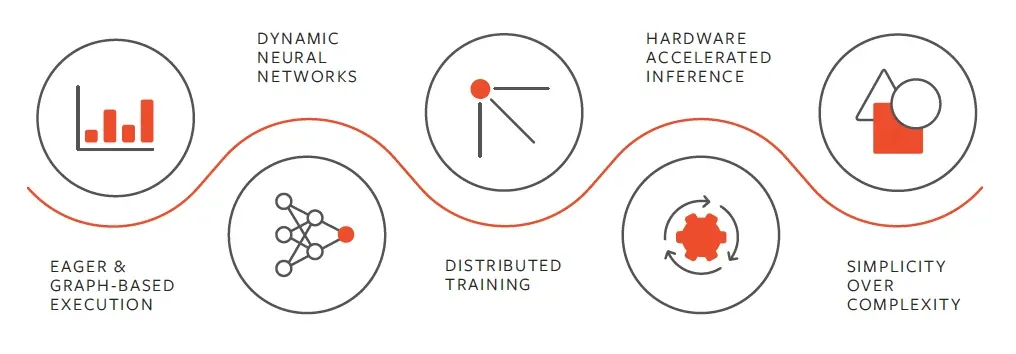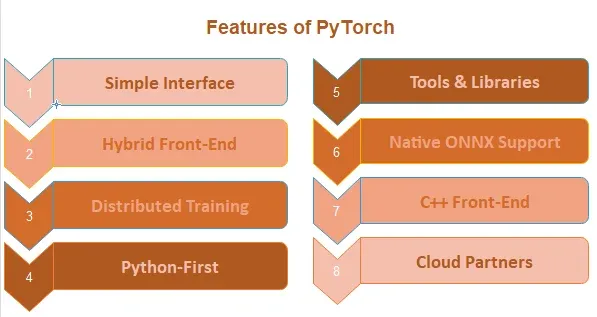In this technological era, Chainer and PyTorch emerge as formidable contenders, each vying for supremacy in the realm of deep learning frameworks.
With both being best, how do you decide between Chainer and PyTorch?
Chainer, known for its dynamic computational graph approach, offers flexibility and intuitive design, empowering developers to wield neural networks with finesse.
On the other side of the ring stands PyTorch, revered for its elegance and simplicity, providing a seamless experience for both beginners and seasoned practitioners.
In this post, we'll break down the key differences between these two popular Python-based frameworks. We'll look at features like model definition syntax, GPU support, community size, etc.
Continue reading to find out more about Chainer vs PyTorch.
What are Chainer and PyTorch?
Chainer and PyTorch are powerful deep learning frameworks that give you the tools and libraries to build and train neural networks.
While they share the same goal, they have unique features and characteristics.
Chainer: Dynamic and Flexible
Chainer stands out for its dynamic computational graph, which makes experimenting and prototyping a breeze.
With Chainer, you can design and adjust your neural network architecture on the fly. This flexibility makes it an excellent choice for researchers and developers who value adaptability.
Moreover, Chainer's support for custom architectures and operations gives you the freedom to explore innovative ideas.
PyTorch: Ecosystem and Research Focus
Conversely, PyTorch has a solid ecosystem and easy interaction with major Python modules and tools. Its user-friendly interface and support for dynamic computational graphs have piqued the interest of the scientific community.
PyTorch's autograd system simplifies gradient computation, making it a favorite among researchers and academics.
Now, it’s time to know why to choose Chainer and PyTorch.

Why choose Chainer?
Chainer is a powerful yet flexible library that handles all the heavy, so you can focus on solving problems.
Keep reading to discover Chainer's unique advantages and why it may be the ideal choice for your project.
Ease of Use and Flexibility
Chainer's dynamic computational graph lets you define and modify your network architecture on the go. This flexibility makes it easy to experiment with different models and iterate quickly.
Whether you're a beginner or an experienced deep learning practitioner, Chainer's intuitive API and extensive documentation will make your journey smoother.
Performance and Scalability
Chainer is renowned for its efficient memory management and computational prowess. It can efficiently utilize multiple GPUs and even scale across distributed systems, making it an ideal choice for large-scale projects.
If you're working on computationally intensive tasks, Chainer's performance capabilities will surely impress you.
Documentation and Community Support
Chainer boasts a vibrant community and offers comprehensive documentation and tutorials. Whether seeking help on forums or exploring open-source projects, you'll find ample support.
The community's active engagement and regular updates ensure you'll always have access to the latest advancements in deep learning.
Chainer Commander: Streamlining Deep Learning Workflow
One notable feature of Chainer is Chainer Commander, a tool that streamlines the deep learning workflow. Chainer Commander simplifies the process of managing experiments, allowing you to easily track and reproduce your results.
With its intuitive command-line interface, you can focus more on your models and less on the logistics.
Now it’s time to know the reason why choose PyToch.
Suggested Reading-
Why choose PyTorch?
PyTorch is a deep learning framework that empowers you with speed, flexibility and scalability.
See why cutting-edge companies and top researchers choose PyTorch to fuel their machine learning:

Pythonic and Intuitive Syntax
PyTorch is based on Python, a programming language noted for its ease of use and readability.
PyTorch code is very simple to comprehend and write, even for beginners. Because of its simple syntax, you can concentrate on the logic of your deep learning models rather than becoming bogged down in complicated code structures.
PyTorch's Pythonic nature also enables smooth connection with other Python libraries, making it a versatile solution for a wide range of applications.
Dynamic Computational Graphs
One of the standout features of PyTorch is its dynamic computational graph. Unlike static computational graphs used by some other frameworks, PyTorch allows you to define and modify your computational graph on the fly.
The flexibility allows you to experiment with various model designs and modify your network topology during runtime. PyTorch's dynamic nature makes it a good choice for research and development, where quick experimentation is essential.
Strong Research Focus
PyTorch has grown in popularity among researchers due to its strong research focus. PyTorch is used to build many cutting-edge research articles and projects, and the framework has grown into a go-to choice for researchers worldwide.
PyTorch includes many pre-trained models and tools that aid with transfer learning and make sophisticated deep-learning models easier to develop.
PyTorch's active research community guarantees that you have access to the most recent advances and approaches in the field.
How do Chainer and PyTorch compare?
When it comes to choosing the right deep learning framework, it's essential to consider various factors such as syntax, performance, community support, and ecosystem.
Let's explore how Chainer and PyTorch fare in these aspects.
Syntax and API
Chainer and PyTorch have different approaches to syntax and API design.
Chainer follows a more imperative programming style, where the network is defined dynamically during runtime.
On the other hand, PyTorch embraces a similar approach, allowing for dynamic computation graphs.
Both frameworks provide intuitive APIs that make it easy to define and train neural networks. It ultimately comes down to personal preference and the programming style that suits you best.
Performance and Efficiency
Chainer and PyTorch both provide efficient computation capabilities in terms of performance.
Chainer is well-known for its efficient memory management and computational efficiency, which makes it an ideal choice for large-scale applications.
PyTorch, on the other hand, enables high-performance computing using GPU acceleration and optimized tensor operations.
Community and Support
The size and activity of the community surrounding a deep learning framework can greatly impact your development experience.
Chainer has a dedicated and active community, with comprehensive documentation and tutorials readily available. The community is known for its responsiveness and willingness to help fellow developers.
PyTorch, backed by Facebook AI, has increased in popularity and has a sizable and active community. It offers many resources, such as tutorials, forums, and research papers, making it simple to obtain help and stay current on the latest advances.
Ecosystem and Integration
The ecosystem and integration capabilities of a deep learning framework play a crucial role in its usability.
Chainer integrates well with popular Python libraries and tools, allowing you to leverage existing resources seamlessly.
PyTorch, with its strong ecosystem, offers compatibility with other deep learning frameworks, making it easy to combine models and leverage pre-trained networks.
Both frameworks provide access to pre-trained models and datasets, saving you valuable time and effort.
Conclusion
In conclusion, the choice between Chainer and PyTorch ultimately depends on the specific needs and preferences of the user.
Chainer's dynamic computation graph offers flexibility for experimentation and rapid prototyping, making it an attractive option for those who value ease of use and quick iteration.
On the other hand, PyTorch's adoption of a static computation graph and its extensive community support make it a robust framework for large-scale projects and production environments.
Both frameworks have their strengths and weaknesses, and users should consider factors such as learning curve, community support, and project requirements when making a decision.
For large-scale, Chainer may have an edge to its capabilities. However, a versatile choice suitable for both research.
You cannot go wrong with either - choose based on the factors that matter most for your projects.
Frequently Asked Questions (FAQs)
Which deep learning framework is better for beginners: Chainer or PyTorch?
Both Chainer and PyTorch have user-friendly interfaces and extensive documentation, making them suitable for beginners.
However, PyTorch's intuitive syntax and strong community support make it a popular choice for beginners.
Can you use Chainer and PyTorch together in the same project?
Yes, it is possible to use Chainer and PyTorch together in the same project.
Both frameworks provide interoperability with other deep learning libraries, allowing you to combine models and leverage the strengths of each framework.
Which framework offers better performance: Chainer or PyTorch?
Both Chainer and PyTorch offer efficient performance for deep learning tasks.
Chainer is known for its efficient memory management and computational performance, while PyTorch leverages GPU acceleration and optimized tensor operations.
The choice depends on the specific requirements of your project.
Are there any limitations to using Chainer or PyTorch?
Chainer and PyTorch have their own limitations. Chainer's dynamic computational graph may require additional effort for scalability, while PyTorch's eager execution mode may result in slower performance for certain tasks.
It's important to consider these limitations when choosing a framework.
Which framework has better community support: Chainer or PyTorch?
Both Chainer and PyTorch have active and supportive communities.
PyTorch, backed by Facebook AI, has gained significant traction in the research community, while Chainer has a dedicated community that offers comprehensive documentation and tutorials.
Can you deploy models trained in Chainer or PyTorch to production?
Yes, models trained in both Chainer and PyTorch can be deployed to production.
Both frameworks provide tools and libraries for model deployment, and there are various deployment options available depending on your specific requirements.


